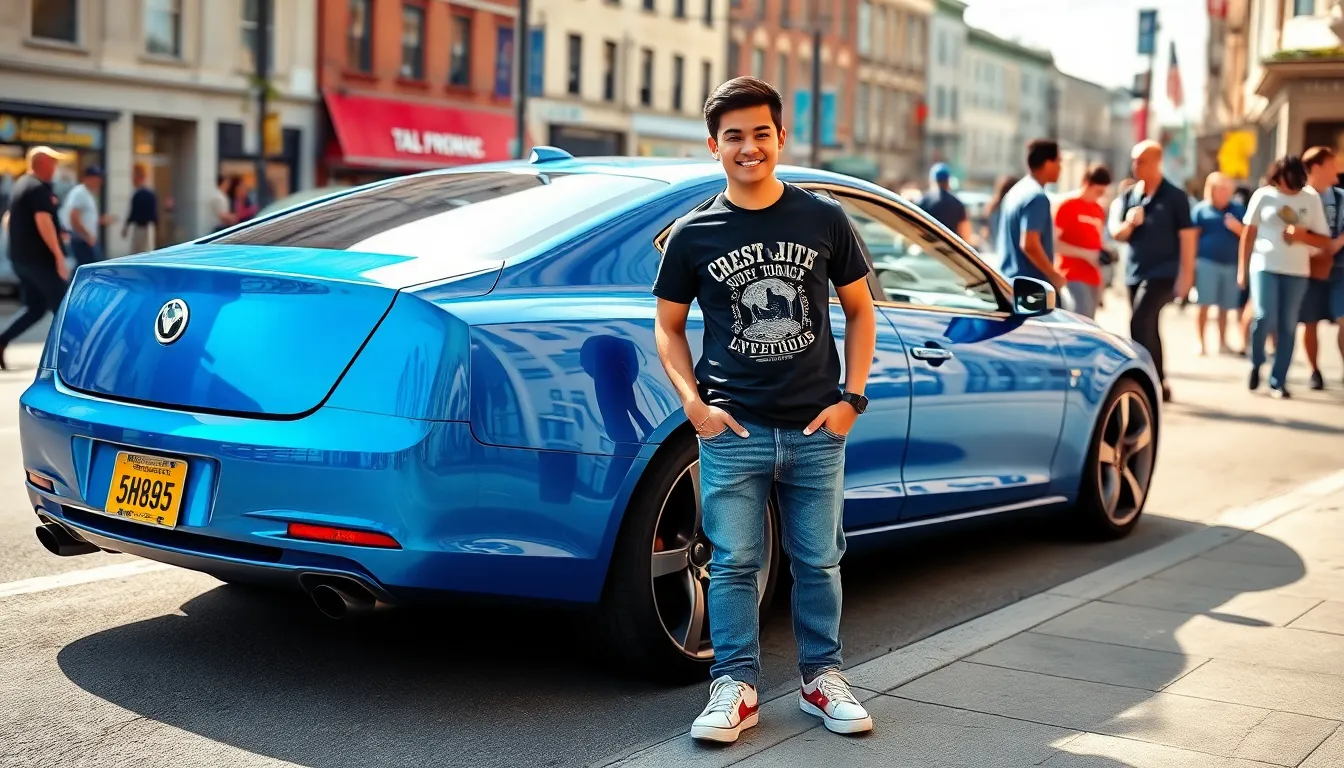We’ve all seen those cars that seem to glow from within – their paint shifting between deep, rich colors that catch every ray of sunlight. That’s the magic of candy paint, and it’s transforming ordinary vehicles into rolling works of art across America’s streets.
Candy paint isn’t just another automotive finish – it’s a multi-layered masterpiece that creates depth and brilliance impossible to achieve with traditional paint jobs. From classic muscle cars to modern luxury vehicles, this stunning technique has captured the hearts of car enthusiasts who want their rides to stand out from the crowd.
Whether you’re considering a candy paint makeover for your own vehicle or simply curious about this eye-catching automotive trend, we’ll explore everything you need to know about candy paint cars. From the intricate application process to maintenance tips that keep that gorgeous finish looking fresh for years to come.
What Are Candy Paint Cars and Why They’re Taking the Automotive World by Storm
Candy paint cars showcase a revolutionary finishing technique that creates breathtaking visual effects through multiple transparent layers. These stunning automotive masterpieces have captured the attention of car enthusiasts worldwide with their unmatched depth and brilliance.
The Science Behind Candy Paint’s Translucent Magic
Candy paint achieves its mesmerizing appearance through a precise three-layer system that manipulates light in extraordinary ways. We start with a metallic base coat that provides the reflective foundation, typically silver or gold flakes suspended in primer. This reflective layer acts as a mirror beneath the subsequent transparent layers.
The magic happens when we apply the translucent candy color coat over the metallic base. Light penetrates through this colored layer, bounces off the metallic base, and travels back through the candy layer again. This double light transmission creates an incredible depth that appears to glow from within the paint itself.
Multiple thin candy coats build up the desired color intensity and create different visual effects at various viewing angles. Each additional layer deepens the color while maintaining the translucent quality that makes candy paint so captivating. The final clear coat protects these delicate layers while adding even more depth and gloss to the finish.
How Candy Paint Differs from Traditional Automotive Finishes
Traditional automotive paints rely on opacity to create color, using pigments that block light rather than allowing it to pass through. Standard paint jobs typically consist of primer, base color, and clear coat in a straightforward application process. The color you see is essentially what sits on the surface of the vehicle.
Candy paint systems require significantly more skill and precision during application than conventional finishes. We must maintain consistent spray patterns and overlap techniques because any variation in application thickness becomes permanently visible in the final result. Traditional paints allow for minor application inconsistencies that can be corrected with polishing or additional coats.
Color matching presents another major difference between these finishing methods. Standard automotive paints can be matched using computerized color systems and touch up work remains relatively simple. Candy paint colors depend entirely on the base coat metallic and the number of candy layers applied, making exact color matching extremely difficult.
Cost differences between these paint systems reflect the complexity and materials involved. Traditional paint jobs typically range from $500 to $3,000 depending on quality and vehicle size. Candy paint applications start around $3,000 and can exceed $10,000 for show quality finishes due to the specialized materials and extensive labor requirements.
Top 5 Most Popular Candy Paint Colors for Modern Vehicles
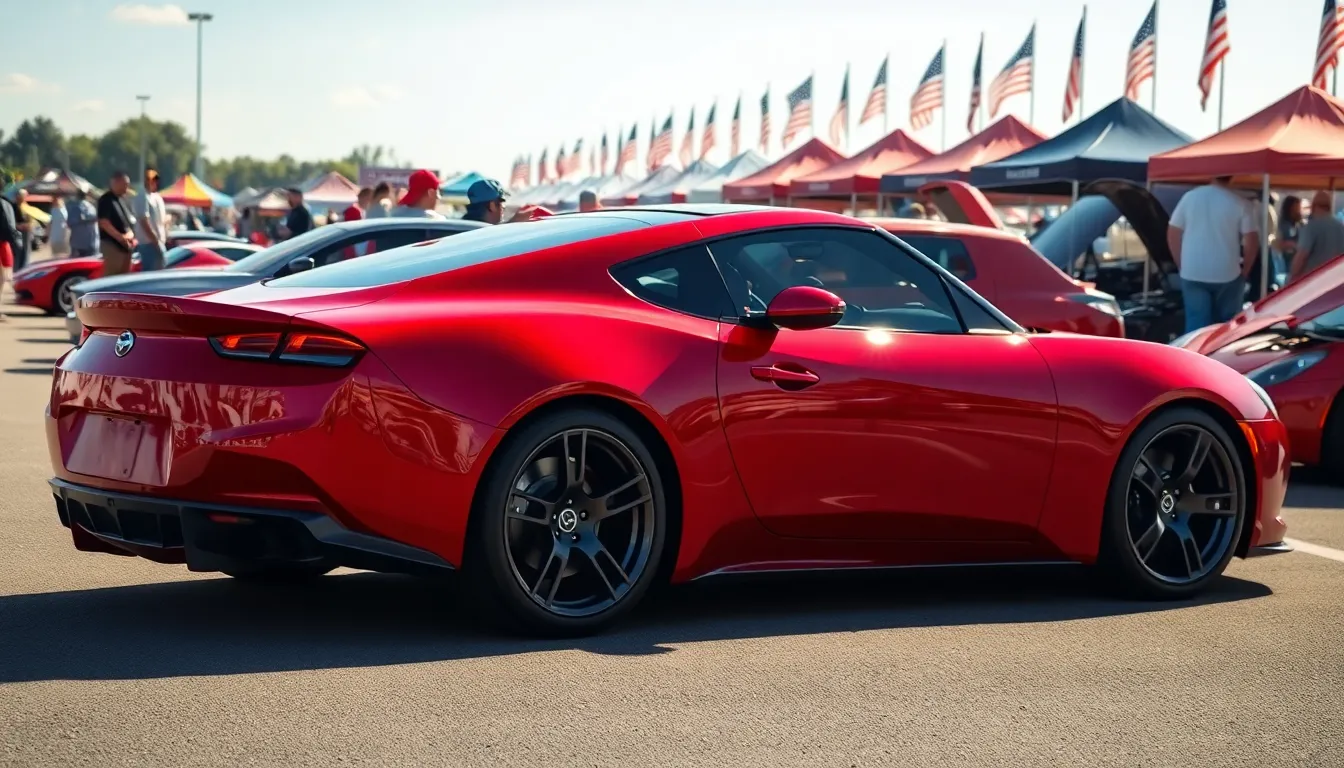
Modern car enthusiasts continue to gravitate toward exact candy paint colors that deliver maximum visual impact. These five colors dominate the custom automotive scene due to their stunning light interaction and street presence.
Classic Cherry Red Candy Paint
Cherry red candy paint remains the most sought-after color in the custom car industry, offering unmatched depth and richness. This timeless finish creates a deep burgundy appearance in shadows that transforms into brilliant crimson when sunlight hits the surface. Professional shops report that cherry red accounts for approximately 35% of all candy paint applications, making it the clear favorite among car owners seeking dramatic transformation.
The metallic base coat for cherry red typically uses silver or gold flakes to enhance the color’s luminosity. Multiple candy red coats build the desired intensity, with most applications requiring 3-4 translucent layers for optimal results. Custom painters often recommend cherry red for classic muscle cars and modern sports vehicles due to its universal appeal and proven resale value retention.
Electric Blue Candy Finishes
Electric blue candy paint delivers striking visual impact that commands attention on any street or car show. This vibrant finish shifts from deep navy in low light to brilliant electric blue under direct sunlight, creating an almost neon-like glow. Car enthusiasts particularly favor electric blue for import tuners and modern performance vehicles where bold aesthetics match aggressive styling.
The application process for electric blue requires precise temperature control during spraying to prevent color variations. Most professional painters use a bright silver metallic base to maximize the blue’s luminosity and depth. Electric blue candy paint typically costs 15-20% more than standard candy colors due to the specialized pigments required for its intense saturation.
Emerald Green Candy Coats
Emerald green candy paint offers a sophisticated alternative to more common candy colors while maintaining exceptional visual drama. This rich finish appears almost black in shadows before revealing brilliant emerald tones when light strikes the surface. Luxury vehicle owners often choose emerald green for its unique combination of elegance and eye-catching appeal that sets their cars apart from typical red and blue candy finishes.
The metallic base for emerald green candy typically incorporates gold or bronze flakes to create warm undertones. Professional application requires 4-5 translucent green coats to achieve the signature depth that makes this color so compelling. Emerald green candy paint works exceptionally well on larger vehicles like SUVs and luxury sedans where the expansive surface area showcases the color’s full potential.
Purple Grape Candy Paint
Purple grape candy paint creates one of the most dramatic color-shifting effects available in automotive finishes today. This deep finish ranges from rich plum in low light to vibrant purple with magenta highlights under direct sunlight. Custom car builders frequently select purple grape for show vehicles and weekend cruisers where maximum visual impact takes priority over subtlety.
The application technique for purple grape requires careful layer management to prevent oversaturation that can muddy the color’s clarity. Silver metallic base coats work best with purple candy to maintain brightness and prevent the finish from appearing too dark. Purple grape candy paint typically requires 3-4 translucent coats with extended flash times between applications to ensure proper color development.
Orange Creamsicle Candy Colors
Orange creamsicle candy paint combines warmth and vibrancy to create one of the most cheerful automotive finishes available. This unique color shifts from deep amber in shadows to bright tangerine orange in sunlight, evoking the nostalgic appeal of the classic frozen treat. Hot rod enthusiasts and classic car restorers particularly appreciate orange creamsicle for its retro aesthetic and exceptional show quality appearance.
The metallic base for orange creamsicle typically uses gold or copper flakes to enhance the color’s warm undertones. Professional painters recommend 3-4 translucent orange coats with careful attention to spray patterns to prevent streaking. Orange creamsicle candy paint offers excellent durability and fade resistance compared to other warm-toned candy colors, making it practical for daily-driven vehicles seeking distinctive style.
Essential Steps in the Candy Paint Application Process
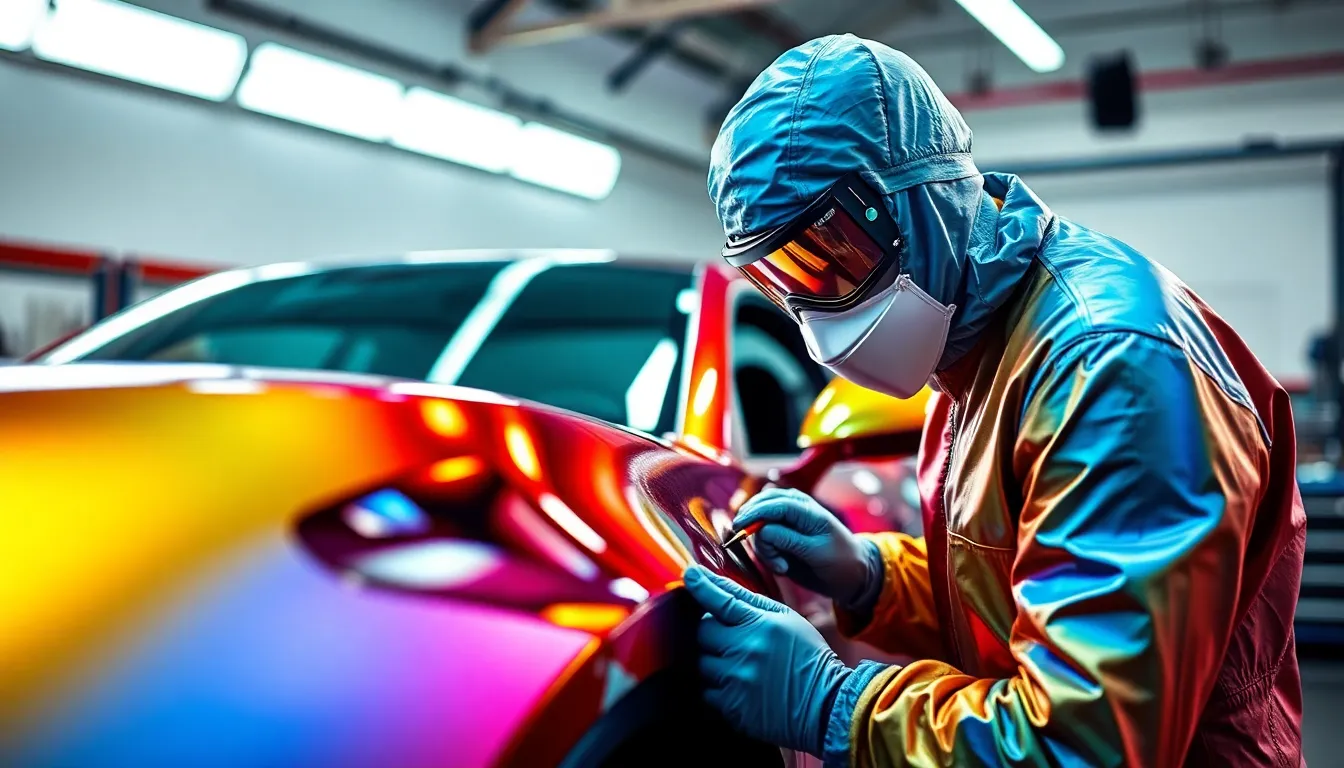
Mastering the candy paint application process requires precise execution and attention to detail at every stage. We’ll walk you through the essential steps that professional painters follow to achieve those stunning, translucent finishes.
Surface Preparation and Base Coat Requirements
Preparation forms the foundation of any successful candy paint job. We start by completely stripping the existing paint using chemical strippers or sandblasting to ensure perfect adhesion. Every surface imperfection becomes magnified under candy paint’s translucent layers, so we sand the entire vehicle using progressively finer grits from 400 to 800 grit.
Body work comes next, requiring us to fill any dents or scratches with high-quality automotive filler. We apply primer sealer to create a uniform surface that prevents color variations in the final finish. Temperature control matters significantly during this phase, with ideal conditions ranging between 70-75°F and humidity levels below 50%.
Base coat selection determines the final appearance of our candy paint finish. We typically use silver or white metallic base coats to maximize light reflection and color vibrancy. Black base coats create deeper, more dramatic effects but require additional candy color layers to achieve full coverage.
Applying the Metallic Base Layer
Metallic base application requires steady hands and consistent spray patterns. We thin the metallic base coat according to manufacturer specifications, typically using a 2:1 ratio of paint to reducer. Gun pressure stays between 25-30 PSI to ensure even metallic particle distribution across the surface.
Coverage happens in light, overlapping coats rather than heavy applications. We apply 2-3 thin coats with 15-minute flash times between each layer, allowing proper solvent evaporation. Distance from the spray gun to the surface remains consistent at 6-8 inches throughout the process.
Metallic orientation becomes critical for uniform appearance. We maintain the same spray angle and direction for all coats to prevent mottling or uneven metallic flake distribution. Flash time after the final metallic coat extends to 30 minutes before proceeding to the candy color application.
The Critical Candy Color Coat Application
Candy color application demands the most skill and patience in the entire process. We reduce the candy paint using slow evaporating thinners to extend working time and improve flow characteristics. Mixing ratios typically range from 3:1 to 4:1, depending on the exact candy color and desired intensity.
Light coats build color gradually without creating runs or sags. We apply the first candy coat at 50% opacity, allowing us to monitor color development and make adjustments. Each subsequent coat adds depth and richness, with most applications requiring 3-5 candy coats for full color saturation.
Overlap patterns stay consistent to prevent striping or color variations. We use 50% overlap on each pass and maintain wet edge control by working in manageable sections. Flash time between candy coats extends to 20-30 minutes, ensuring proper solvent release before the next application.
Color matching becomes easier when we spray test panels first. We document the number of coats and application techniques used to achieve the desired color intensity. This reference helps maintain consistency across large surfaces or when performing future touch-up work.
Clear Coat Protection and Finishing Touches
Clear coat protection preserves the candy paint’s beauty and provides durability. We apply 2-3 coats of high-quality automotive clear coat, allowing 15-20 minutes flash time between applications. UV protection additives in the clear coat prevent candy colors from fading or shifting over time.
Wet sanding begins after the clear coat fully cures, typically 24-48 hours depending on temperature and humidity. We use 1000 grit wet sandpaper to remove any texture or imperfections, followed by 1500 and 2000 grit for smoothness. Water temperature stays cool to prevent clear coat softening during the sanding process.
Polishing brings out the final luster using compound and polish designed for automotive clear coats. We work in small sections using circular motions with a foam polishing pad. Final buffing with a clean microfiber cloth removes any polishing residue and reveals the full depth of the candy paint finish.
Quality inspection involves checking for color consistency, gloss uniformity, and surface defects under different lighting conditions. We examine the finish in direct sunlight, fluorescent lighting, and shade to ensure the candy paint displays properly in all environments.
Cost Breakdown: What You’ll Pay for Professional Candy Paint Cars
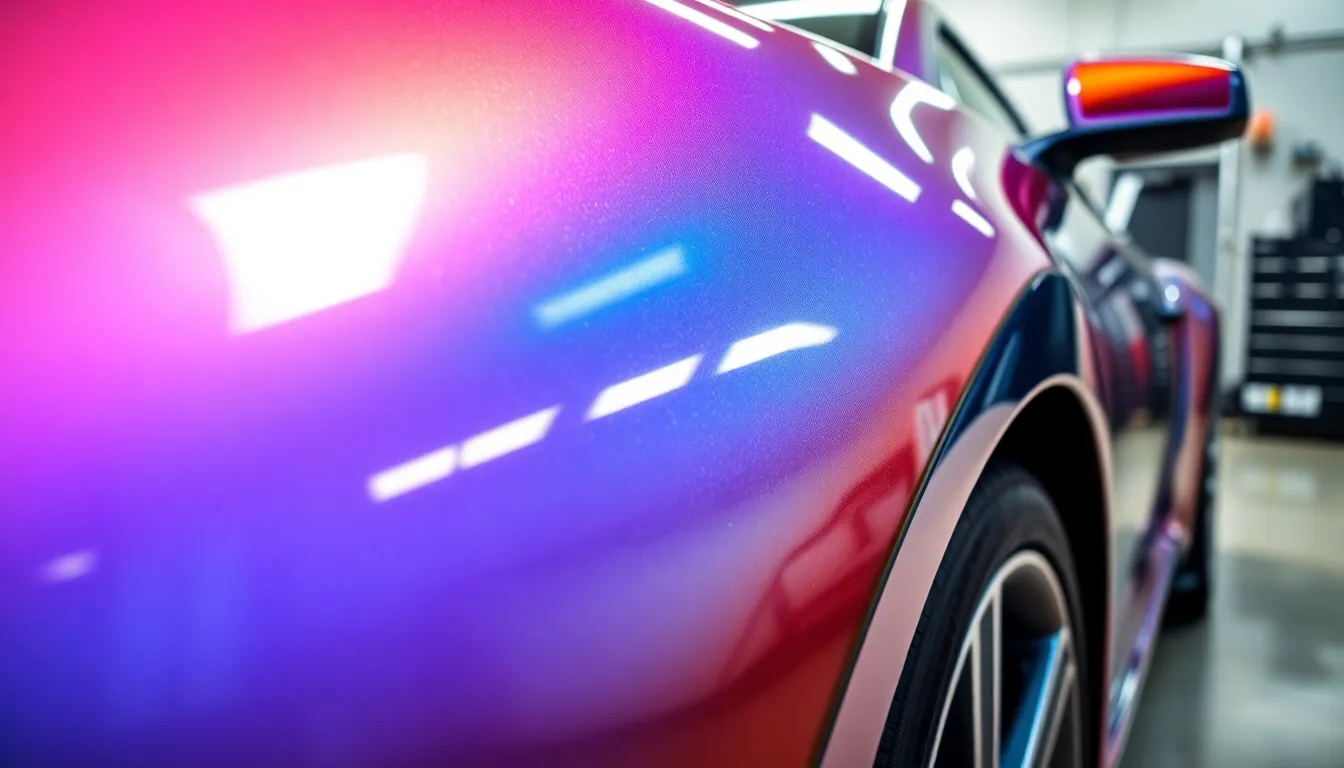
Understanding the complete financial investment for candy paint cars helps you budget effectively and make informed decisions. We’ll break down every cost component so you know exactly where your money goes.
Labor Costs for Professional Application
Professional candy paint application commands premium pricing due to the specialized skills required. Skilled painters typically charge between $75 to $150 per hour for candy paint work, with complete jobs requiring 40 to 80 hours depending on vehicle size and complexity.
| Labor Component | Time Required | Cost Range |
|---|---|---|
| Surface preparation | 8-15 hours | $600-$2,250 |
| Base coat application | 6-10 hours | $450-$1,500 |
| Candy coat layers | 12-20 hours | $900-$3,000 |
| Clear coat and finishing | 8-12 hours | $600-$1,800 |
| Wet sanding and polishing | 6-10 hours | $450-$1,500 |
Total labor costs typically range from $3,000 to $10,050 for a complete candy paint job on a standard vehicle. Luxury vehicles and show cars often require additional time for perfection, pushing labor costs toward the higher end of this spectrum.
Material Expenses and Paint Quality Tiers
Material costs vary significantly based on paint quality and brand selection. We’ve identified three distinct quality tiers that affect both appearance and durability of candy paint cars.
Budget Tier Materials ($500-$1,200)
- Generic candy paints from automotive supply stores
- Standard primer and clear coat systems
- Basic metallic base coats with limited color options
- Adequate for hobbyist projects but shorter lifespan
Professional Tier Materials ($1,200-$3,000)
- Name brand candy paints like House of Kolor or PPG
- High quality automotive primers and clear coats
- Premium metallic base coats with enhanced durability
- UV resistant formulations for long term color retention
Show Quality Materials ($3,000-$6,000)
- Top tier candy paint systems from Dupli Color or Custom Shop
- Multi stage clear coat systems with maximum depth
- Exotic metallic base coats with unique flake patterns
- Specialized additives for enhanced color shifting effects
Additional Costs for Custom Designs and Effects
Custom candy paint designs and special effects significantly increase project costs beyond standard solid color applications. We’ve compiled the most common upgrades that candy paint car owners request.
Graphics and Airbrushing ($500-$5,000)
- Simple stripe patterns or fading effects start around $500
- Complex airbrush artwork ranges from $1,500 to $3,500
- Full vehicle murals or intricate designs can exceed $5,000
- Masking time for multi color schemes adds substantial labor costs
Special Effects and Techniques ($800-$4,000)
- Pearl additives for enhanced shimmer effects cost $300-$800
- Color changing pigments add $1,000-$2,500 to material costs
- Metallic flake upgrades range from $400-$1,200 depending on size
- Multi tone fade effects require additional spray gun setups
Surface Modifications ($1,000-$8,000)
- Body kit integration and painting adds $2,000-$5,000
- Custom panel modifications require fabrication time
- Chrome delete services for trim pieces cost $500-$1,500
- Engine bay candy paint applications add $1,500-$3,000
- Paint protection film application costs $800-$1,500
- Ceramic coating services range from $400-$1,200
- Touch up paint kits and maintenance supplies cost $100-$300
- Annual maintenance contracts with shops run $200-$600
Maintenance Requirements for Candy Paint Cars

Preserving the stunning visual depth of candy paint finishes requires dedicated care and specialized maintenance techniques. We’ll explore the essential practices that keep these translucent masterpieces looking their absolute best.
Daily Care and Washing Techniques
Weekly washing schedules protect candy paint layers from environmental contaminants that can dull the translucent finish. We recommend using the two-bucket method with microfiber wash mitts to prevent swirl marks on the delicate surface.
pH-neutral car shampoos maintain color vibrancy without stripping the protective clear coat. Products like Chemical Guys Mr. Pink or Meguiar’s Gold Class preserve the metallic base coat’s reflective properties while cleaning effectively.
Drying techniques require premium microfiber towels or chamois to avoid water spots that appear more prominently on candy finishes. We suggest patting rather than dragging the towel across the surface to minimize micro-scratching.
Automated car washes damage candy paint applications through harsh brushes and recycled water systems. Hand washing remains the safest method for maintaining the multi-layer system’s integrity and visual depth.
UV Protection and Garage Storage Tips
Covered parking prevents UV degradation of the translucent candy color coat that creates the signature depth effect. Direct sunlight exposure for extended periods can cause color fading within 2-3 years without proper protection.
Ceramic coating applications enhance UV resistance by adding a sacrificial layer above the clear coat. Professional-grade coatings like Gtechniq Crystal Serum Ultra provide 5-7 years of enhanced protection for candy paint investments.
Car covers require breathable materials to prevent moisture buildup that can cause clear coat delamination. We recommend custom-fit covers made from solution-dyed acrylic fabrics that resist UV transmission.
Indoor storage maintains optimal conditions with temperature control between 60-75°F and humidity levels below 50%. Climate-controlled garages prevent thermal expansion that can stress the multiple paint layers.
Touch-Up Procedures for Minor Scratches
Surface assessment determines repair complexity since candy paint scratches affect different layers requiring exact approaches. Light scratches in the clear coat respond to polishing compounds, while deeper damage needs professional color matching.
Color matching challenges require professional expertise because candy paint’s translucent nature makes DIY repairs nearly impossible. Touch-up paint must match both the metallic base and candy color layers precisely.
Polishing compounds remove minor clear coat scratches using products like Menzerna Super Finish or Chemical Guys V32. We apply these with foam pads at low speeds to avoid heat buildup that damages candy layers.
Professional refinishing becomes necessary for scratches penetrating the candy color coat since home repairs create visible patches. Body shops specializing in custom paint work can blend repairs seamlessly into the existing finish.
Famous Candy Paint Cars That Made History
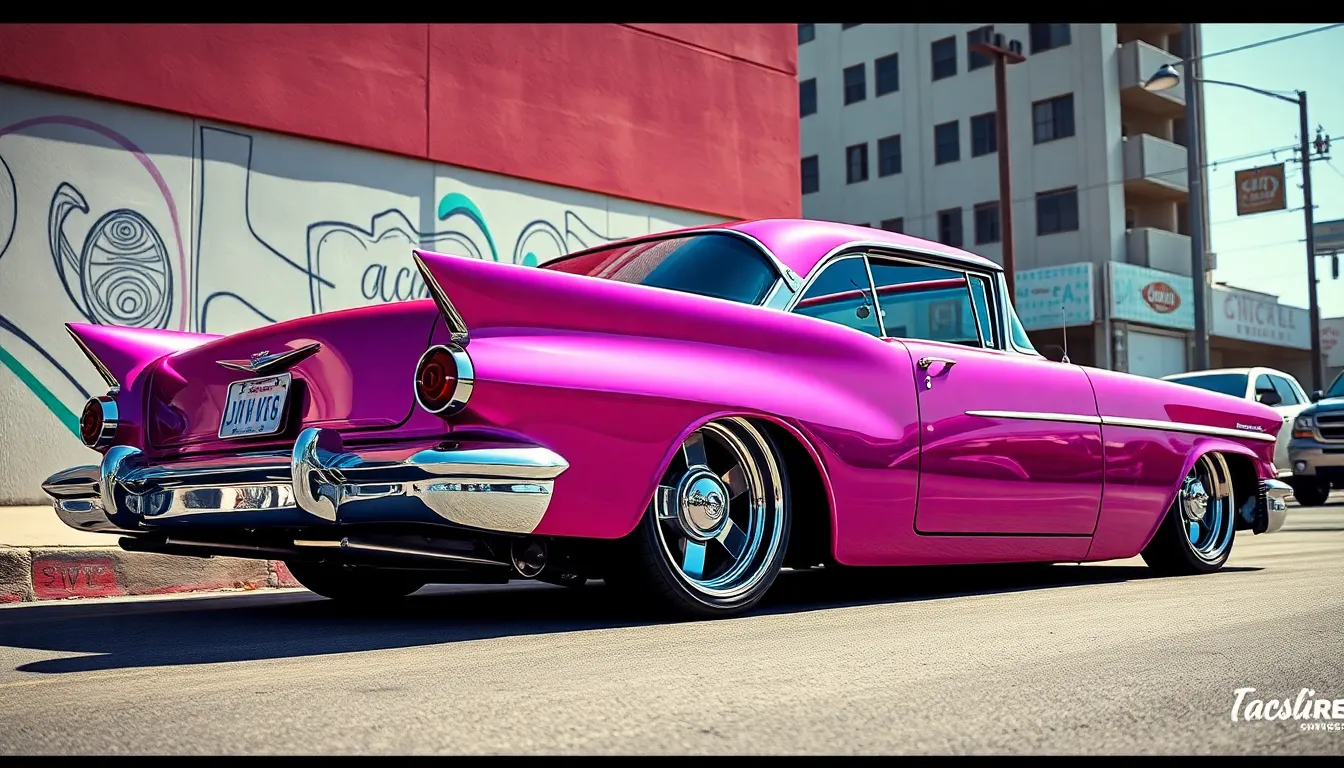
Several legendary vehicles have elevated candy paint from a simple automotive finish to an art form that captures hearts and turns heads on streets worldwide. These iconic automobiles didn’t just showcase stunning colors—they transformed car culture forever.
Lowrider Culture’s Influence on Candy Paint Popularity
East Los Angeles became the birthplace of candy paint culture in the 1960s when lowrider enthusiasts began experimenting with vibrant, translucent finishes on their custom rides. These automotive artists discovered that candy paint perfectly complemented their hydraulic systems and chrome accents, creating visual masterpieces that gleamed under California’s bright sunshine.
Gypsy Rose stands as the most famous candy paint lowrider in history, featuring a stunning pink and purple candy finish that took Jesse Valadez Sr. over four years to complete. This 1963 Chevrolet Impala convertible became the poster child for lowrider culture and demonstrated how candy paint could transform an ordinary car into rolling artwork.
Big Red represents another milestone in candy paint lowrider history, showcasing deep candy apple red over a gold base that created mesmerizing depth effects. Ron Aguirre’s 1958 Chevrolet Impala helped establish red as the most popular candy paint color in lowrider communities across the Southwest.
Traditional lowrider clubs like Groupe Car Club and Imperials Car Club adopted candy paint as their signature style during the 1970s, with members often spending $15,000 to $25,000 on elaborate candy finishes that featured intricate patterns and airbrushed designs.
Celebrity Vehicles with Iconic Candy Finishes
Hollywood’s elite embraced candy paint during the 1990s hip-hop era, turning their luxury vehicles into rolling status symbols that matched their larger-than-life personas. These celebrity endorsements propelled candy paint into mainstream automotive culture.
Snoop Dogg’s 1967 Pontiac Parisienne features an iconic purple candy paint job that perfectly matches his signature style and musical brand. This lowrider convertible, nicknamed “Lil’ Purple,” showcases traditional West Coast candy paint craftsmanship with its deep purple finish over silver metallic base.
Shaquille O’Neal’s custom Superman-themed vehicles include multiple candy paint applications, most notably his blue and red candy-painted motorcycles and cars that reflect his superhero obsession. His collection demonstrates how candy paint works on both two-wheeled and four-wheeled vehicles.
Jay-Z’s Maybach 57S featured a custom candy paint job worth over $30,000, combining deep burgundy candy with gold leaf accents that created an ultra-luxurious appearance. This vehicle showed how candy paint could enhance already expensive automobiles.
Several NASCAR celebrities including Dale Earnhardt Jr. have showcased candy paint finishes on their personal vehicles, bringing this street-level trend into professional racing circles and expanding its appeal to motorsports fans nationwide.
Show Cars That Revolutionized Candy Paint Trends
Professional car shows became the proving grounds where candy paint techniques evolved from simple color applications to complex artistic expressions that pushed the boundaries of automotive customization.
Boyd Coddington’s Smoothster introduced candy paint to hot rod culture in the 1980s, featuring a revolutionary orange candy finish that combined traditional street rod styling with lowrider paint techniques. This 1933 Ford roadster proved that candy paint worked beautifully on classic American hot rods.
Chip Foose’s Hemisfear showcased advanced candy paint application methods at the 2006 SEMA Show, using multiple candy layers to create color-shifting effects that changed from deep purple to burgundy depending on viewing angle. This Plymouth ‘Cuda demonstrated how modern technology enhanced traditional candy paint processes.
House of Kolor’s show vehicles consistently win awards at major automotive events like the Grand National Roadster Show and Goodguys events, with their signature candy concentrates creating benchmark finishes that other painters attempt to replicate.
West Coast Customs’ celebrity builds for MTV’s “Pimp My Ride” brought candy paint into television mainstream during the early 2000s, with Ryan Friedlinghaus’s team creating wild candy combinations that inspired countless enthusiasts to try similar finishes on their own vehicles.
Show quality candy paint applications at events like Barrett-Jackson auctions now command premium prices, with some vehicles selling for $50,000 to $100,000 more than similar cars with standard paint finishes, proving that candy paint adds important collector value to custom automobiles.
DIY vs Professional Application: Making the Right Choice
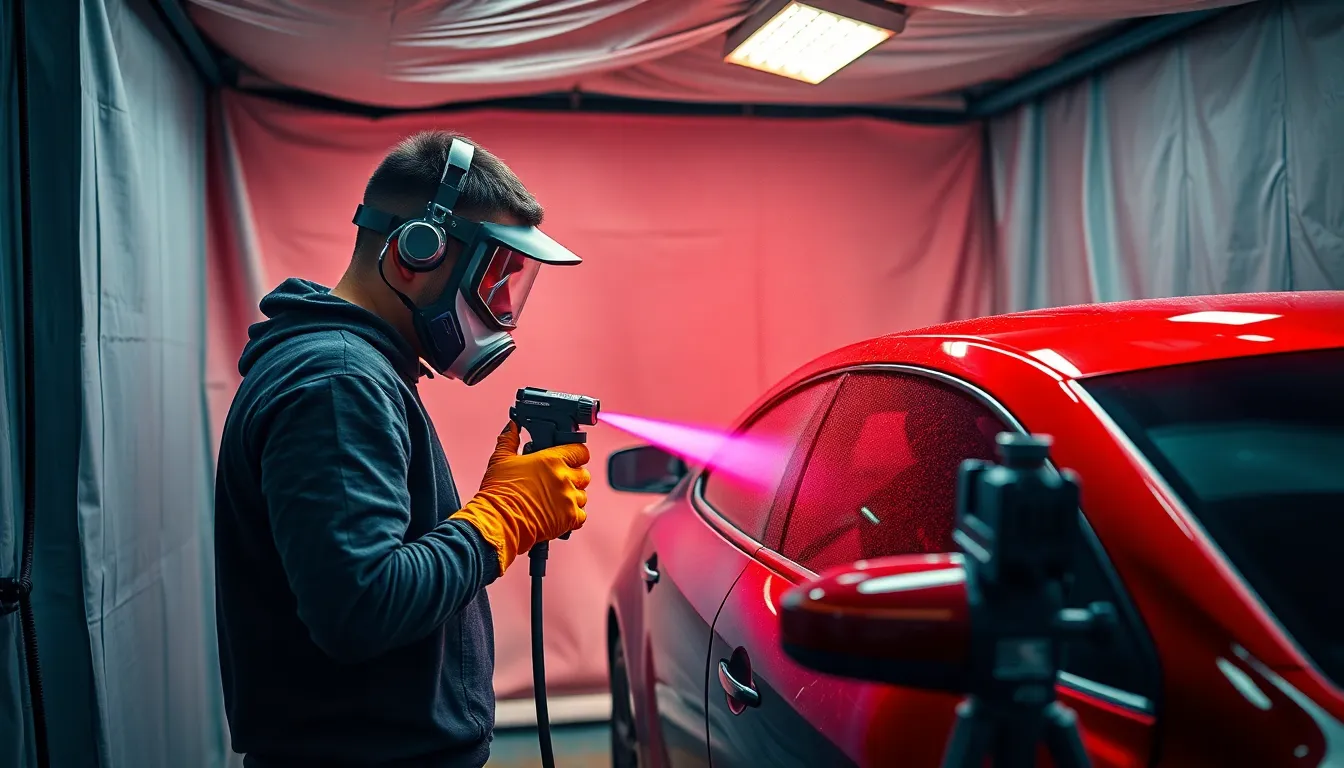
Choosing between DIY and professional candy paint application significantly impacts both your final results and overall investment. We’ll examine the essential requirements, benefits, and potential pitfalls to help you make an well-informed choice.
Tools and Skills Required for DIY Candy Paint Jobs
Specialized spray equipment forms the foundation of any successful candy paint project. We need a high-volume, low-pressure (HVLP) spray gun system with consistent air pressure control, typically costing between $300 and $800 for quality equipment. Professional-grade air compressors delivering at least 10 CFM at 90 PSI ensure proper atomization of candy coats.
Paint booth setup becomes crucial for achieving professional results at home. We must create a dust-free environment using plastic sheeting, adequate ventilation systems, and proper lighting that reveals color consistency during application. Temperature control between 65-75°F and humidity levels below 50% prevent application issues.
Surface preparation tools include various grits of sandpaper (400, 600, 800, 1000, and 1200), orbital sanders, and tack cloths. We need these tools to achieve the mirror-smooth surface that candy paint demands for optimal light reflection and depth.
Color matching expertise requires understanding how different lighting conditions affect candy appearance. We must test spray cards under various light sources and develop an eye for consistent color saturation across multiple coats.
Time investment typically spans 40-60 hours for a complete vehicle, including preparation, base coat application, candy layers, and clear coat finishing. DIY projects often extend over several weeks due to curing times between coats.
Benefits of Professional Installation
Guaranteed results come with professional application, as experienced painters possess the technical knowledge to handle candy paint’s challenging characteristics. Professional shops typically offer warranties ranging from 2-5 years on their candy paint work.
Advanced equipment access includes professional spray booths with precise temperature and humidity control, high-end spray guns, and color matching systems worth $50,000 or more. These tools ensure consistent application quality that’s difficult to replicate in home settings.
Time efficiency dramatically improves with professional installation, as experienced painters complete full candy paint jobs in 5-7 business days versus weeks for DIY attempts. Professional workflow optimization reduces material waste and accelerates project completion.
Color expertise provides access to custom color formulation and matching services that ensure perfect results. Professional painters understand how different candy colors interact with various metallic base coats to achieve desired effects.
Problem resolution capabilities allow professionals to address issues like orange peel, color variation, or contamination during the application process. Their experience prevents costly mistakes that could require complete refinishing.
Common Mistakes to Avoid in Candy Paint Projects
Inadequate surface preparation ruins even the highest-quality candy paint materials. We often see DIY painters skip critical sanding steps or fail to remove all existing paint, resulting in poor adhesion and eventual finish failure.
Improper base coat selection creates color inconsistencies and reduces candy depth. Many beginners choose the wrong metallic base shade, not understanding how it affects the final candy color appearance under different lighting conditions.
Incorrect application technique includes applying coats too thick, maintaining improper gun distance, or using inconsistent spray patterns. These errors create runs, sags, or uneven color saturation that’s nearly impossible to correct without complete refinishing.
Environmental contamination occurs when dust, insects, or debris contaminate the wet paint surface. DIY painters often underestimate the importance of a clean application environment, leading to costly defects.
Rushing cure times between coats causes solvent entrapment, poor adhesion, and eventual finish failure. Each candy layer requires proper flash time before applying subsequent coats, typically 15-30 minutes depending on temperature and humidity.
Color matching challenges become apparent when attempting repairs or touch-ups later. Candy paint’s translucent nature makes it extremely difficult to blend new material with existing finish, often requiring complete panel refinishing for invisible repairs.
Candy Paint Cars in Different Vehicle Categories
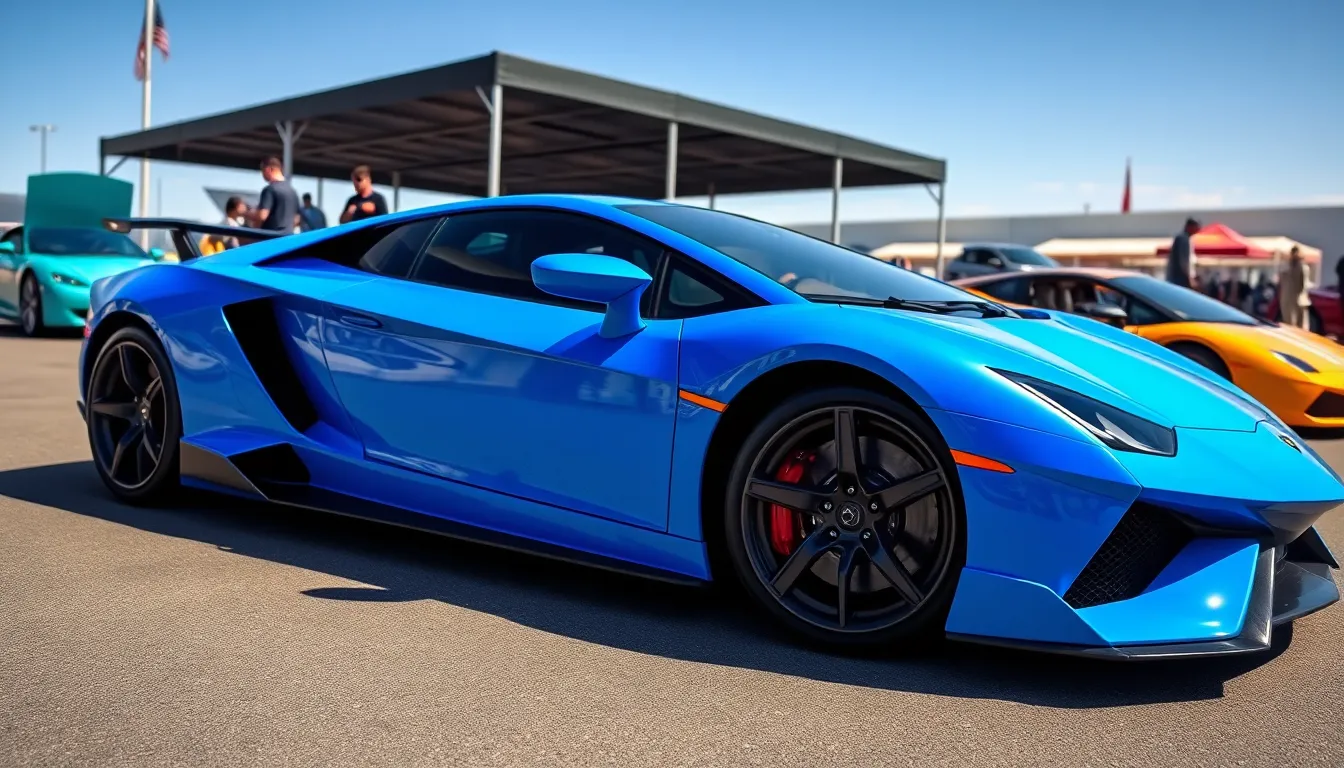
Candy paint transforms vehicles across every automotive category, creating stunning visual masterpieces that command attention on roads and at shows. We’ll explore how different vehicle types showcase candy finishes and the unique considerations for each category.
Sports Cars and Exotic Vehicles
Lamborghinis showcase candy paint’s ability to enhance their already dramatic styling with colors like Electric Blue and Purple Grape. These supercars benefit from candy paint’s depth and color shifting effects that complement their aggressive lines and aerodynamic curves. Professional application costs typically range from $8,000 to $15,000 for exotic vehicles due to their complex body panels and premium finish requirements.
Ferraris often feature custom candy red variations that pay homage to their racing heritage while adding contemporary flair. The translucent candy layers create stunning depth that traditional Ferrari Rosso Corsa cannot match. Many owners choose candy finishes for special edition models or track focused builds.
Porsche 911s and Corvettes frequently receive candy paint treatments that emphasize their performance oriented design. These vehicles work exceptionally well with Emerald Green and Classic Cherry Red applications. The smooth body lines of sports cars allow candy paint’s light reflecting properties to create mesmerizing visual effects.
Classic Muscle Cars and Hot Rods
1969 Dodge Chargers and Plymouth ‘Cudas represent the most popular muscle car platforms for candy paint applications. These vehicles’ iconic body styles provide the perfect canvas for Classic Cherry Red and Orange Creamsicle finishes. Restoration shops often recommend candy paint for show quality builds that demand maximum visual impact.
Ford Mustangs from the 1960s and 1970s frequently receive candy paint treatments during complete restorations. Fastback models particularly benefit from candy finishes that highlight their flowing rooflines and aggressive stance. Professional painters typically charge $5,000 to $8,000 for muscle car candy applications.
Hot rods and street rods showcase some of the most creative candy paint combinations in automotive culture. Model A Fords, ’32 roadsters, and custom builds often feature unique color combinations that reflect their owners’ personalities. These vehicles allow for experimental approaches to candy paint application and custom design work.
Chevrolet Camaros and Firebirds from the 1970s provide excellent platforms for Purple Grape and Electric Blue candy finishes. Their bold styling and muscular proportions complement candy paint’s dramatic visual effects. Many owners choose candy paint to differentiate their vehicles from standard factory colors.
Motorcycles and Custom Bikes
Harley Davidson motorcycles represent the largest segment of candy paint applications in the motorcycle industry. Touring bikes, Softails, and Sportsters frequently receive candy treatments that range from $2,000 to $5,000 depending on the complexity. Custom shops specialize in candy paint applications that complement chrome accessories and leather details.
Sport bikes like Yamaha R1s and Honda CBRs showcase candy paint’s ability to enhance aerodynamic fairings. These motorcycles often feature Electric Blue and Purple Grape finishes that create stunning visual effects at high speeds. The smooth fairing surfaces provide ideal canvases for candy paint application.
Custom choppers and bobbers frequently feature elaborate candy paint schemes that incorporate multiple colors and effects. These builds often combine candy paint with pinstriping, graphics, and metallic accents. Professional motorcycle painters develop specialized techniques for applying candy paint to complex frame geometries and fuel tanks.
Touring motorcycles benefit from candy paint finishes that maintain their visual appeal during long distance rides. Indian Motorcycles and BMW touring bikes often receive candy treatments that emphasize their premium positioning. UV resistant clear coats become particularly important for motorcycles exposed to extended sunlight.
Lowriders and Show Cars
Chevrolet Impalas from the 1960s remain the most iconic lowrider platform for candy paint applications. These vehicles helped establish candy paint’s reputation in automotive culture through legendary builds like Gypsy Rose. Traditional lowrider colors include Classic Cherry Red, Purple Grape, and custom gold variations.
Show cars represent the highest level of candy paint artistry with applications that can exceed $20,000. These vehicles feature multiple candy layers, custom graphics, and specialized effects that require months of preparation. Professional show car builders develop proprietary techniques for achieving perfect candy finishes.
Monte Carlos and Cutlass Supreme models frequently receive candy paint treatments that emphasize their luxury oriented styling. These vehicles’ smooth body lines and chrome accents complement candy paint’s reflective properties. Many lowrider enthusiasts choose these platforms for their ability to showcase elaborate paint schemes.
Modern lowrider builds incorporate contemporary vehicles like Cadillac CTSs and Chrysler 300s with updated candy paint techniques. These applications blend traditional lowrider aesthetics with modern automotive technology. Professional shops adapt classic candy paint methods to work with contemporary paint systems and materials.
Durability and Longevity of Candy Paint Finishes
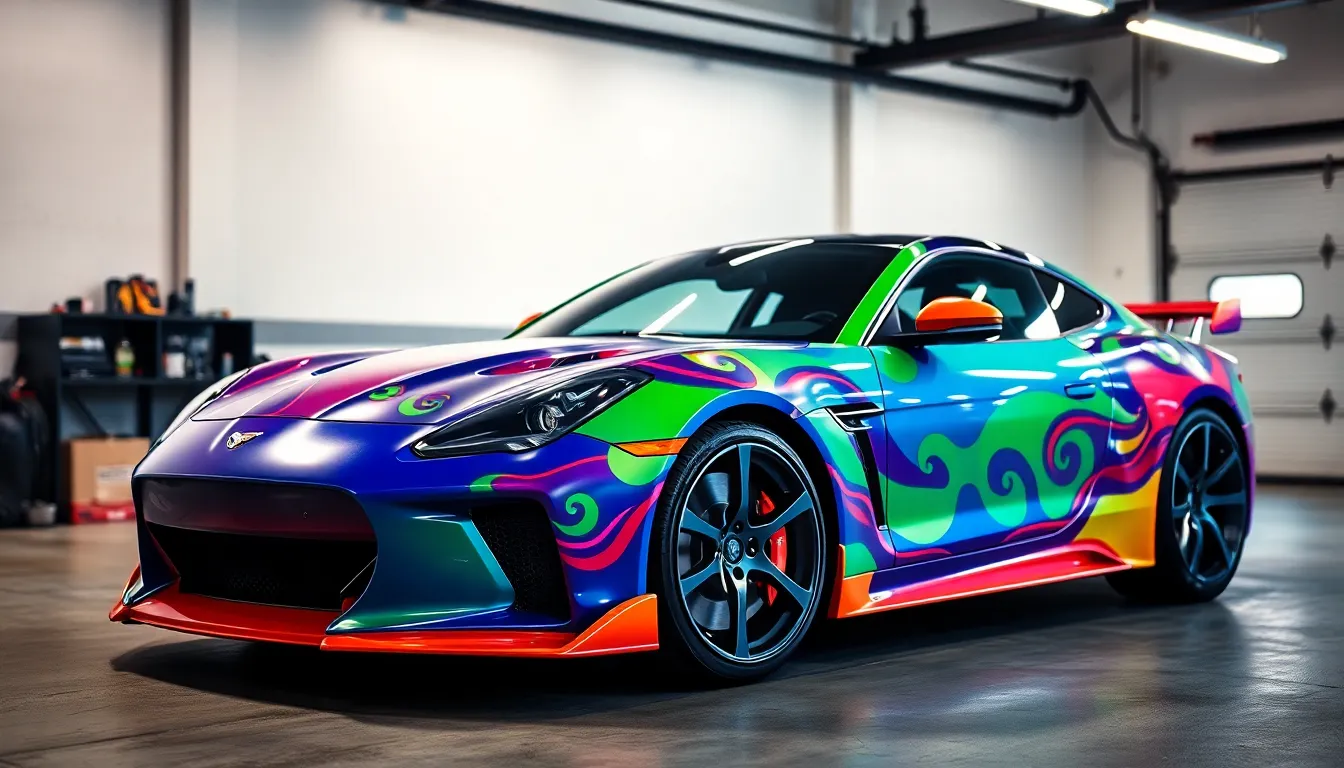
Understanding candy paint durability helps car owners make informed decisions about their automotive investment. Professional candy paint applications offer impressive longevity when properly maintained and protected.
Expected Lifespan Under Normal Conditions
Quality candy paint finishes typically last 5 to 8 years under normal driving conditions. Professional applications using high-grade materials can maintain their vibrant appearance for up to a decade with proper care. Show-quality candy finishes often exceed these timeframes, particularly when vehicles receive garage storage and limited road exposure.
Climate-controlled environments significantly extend candy paint lifespan. Vehicles stored in garages and driven occasionally can preserve their candy finish for 10 to 15 years. Daily drivers exposed to various weather conditions generally require touch-ups or refinishing within the 5 to 7-year range.
Mileage and usage patterns directly impact finish longevity. Weekend cruisers and show cars maintain their candy brilliance longer than daily commuters. Professional detailing every 3 to 6 months helps maximize the expected lifespan regardless of usage patterns.
Factors That Affect Candy Paint Durability
UV exposure poses the greatest threat to candy paint longevity. Direct sunlight breaks down the translucent candy layers, causing color fading and loss of depth. Ceramic coatings and UV-resistant clear coats provide essential protection against solar damage.
Environmental contaminants accelerate candy paint deterioration. Road salt, tree sap, bird droppings, and industrial pollutants can permanently stain or etch the finish. Regular washing with pH-neutral products removes these harmful substances before they cause lasting damage.
Temperature fluctuations stress candy paint layers differently. Extreme heat causes expansion while freezing temperatures create contraction, leading to potential cracking or peeling. Gradual temperature changes in climate-controlled storage minimize thermal stress.
Application quality determines long-term durability performance. Professional installations with proper surface preparation and multiple thin coats outlast DIY applications. Budget-grade materials typically show wear signs within 2 to 3 years compared to professional-grade products.
When to Consider Repainting Your Candy Finish
Color fading indicates the candy layers need professional attention. Noticeable dulling or loss of vibrancy suggests UV damage has compromised the translucent coating. Professional color matching becomes necessary when touch-ups no longer blend seamlessly with surrounding areas.
Surface imperfections warrant repainting consideration when they affect overall appearance. Deep scratches, chips, or oxidation spots that penetrate multiple layers require complete refinishing. Minor surface scratches can often be polished out without full repainting.
Clear coat failure signals immediate repainting needs. Peeling, cloudiness, or orange peel texture in the protective layer compromises the entire candy finish. Delaying repairs at this stage leads to more extensive and expensive restoration work.
Show car standards may require earlier refinishing schedules. Competition vehicles often receive fresh candy paint every 3 to 5 years to maintain pristine appearance. Street-driven cars can typically wait until functional problems develop rather than purely cosmetic concerns.
Future Trends in Candy Paint Technology
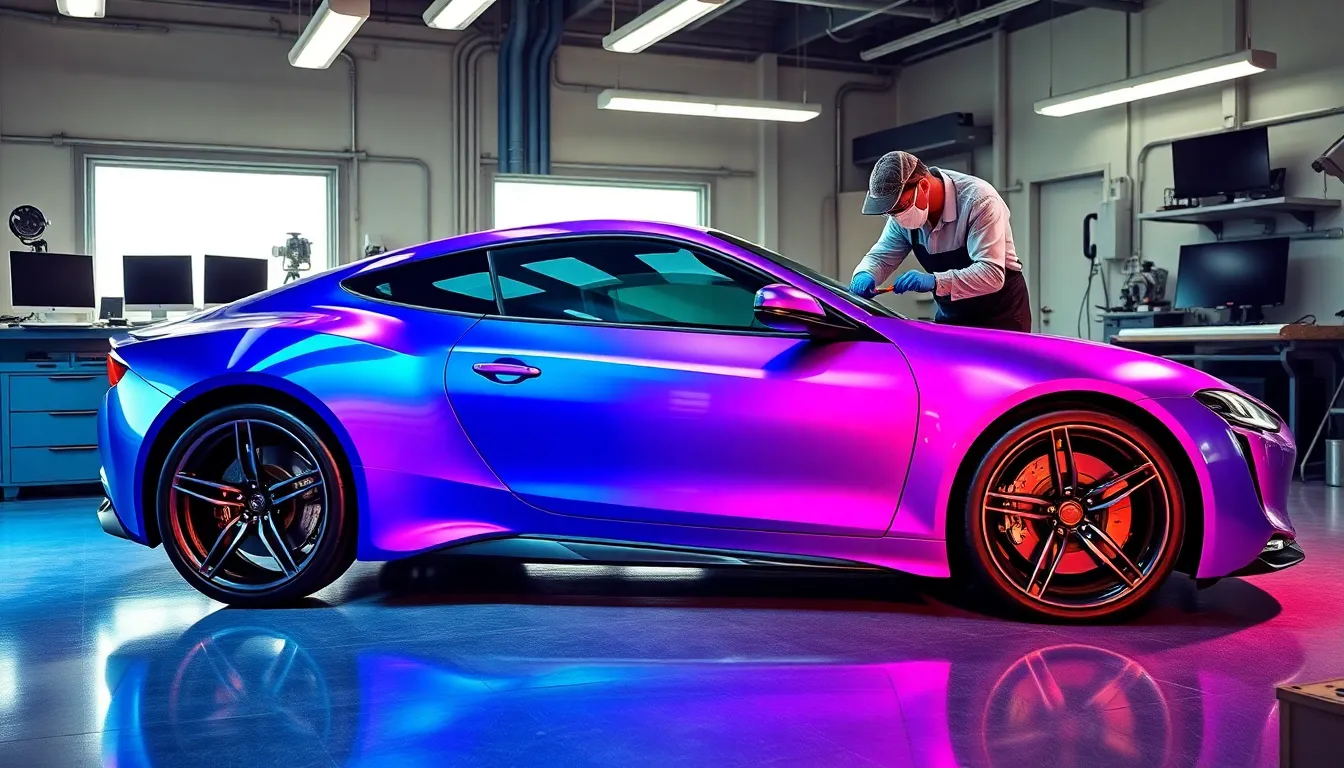
The candy paint industry is experiencing rapid technological advancements that promise to revolutionize how we perceive automotive finishes. These innovations are reshaping the boundaries of what’s possible with translucent color systems.
Color-Changing Candy Paint Innovations
Thermochromic candy paint represents the cutting edge of color-shifting technology, allowing vehicles to change hues based on temperature variations. We’re seeing manufacturers develop formulations that can shift between 3 to 5 different colors as temperatures range from 60°F to 120°F. Leading companies like ChromaFlair and LTI have created candy systems that transition from deep blue to vibrant purple as ambient temperatures increase.
Electrochromic candy paint systems take color-changing technology even further by allowing drivers to control color transitions through electrical signals. BMW’s experimental iX Flow concept vehicle demonstrated this technology in 2022, using e-ink segments beneath candy coatings to create customizable color patterns. Professional installation of electrochromic candy systems currently costs between $15,000 and $25,000, making them exclusive to luxury applications.
Photochromic candy formulations respond to UV light intensity, creating ever-changing color effects throughout the day. Morning applications might display silver undertones, while afternoon sun exposure reveals deep amber or red hues. Companies like Axalta and PPG are developing UV-responsive candy pigments that maintain their color-changing properties for up to 7 years under normal driving conditions.
Smart candy paint systems integrate with vehicle electronics to create programmable color displays. Tesla has filed patents for candy finishes that can display vehicle information, charge status, or custom patterns through embedded LED arrays. We anticipate these systems will debut in premium electric vehicles by 2026, with costs ranging from $8,000 to $12,000 for complete installations.
Eco-Friendly Candy Paint Formulations
Water-based candy paint systems are replacing traditional solvent-based formulations to reduce environmental impact and improve workplace safety. BASF’s new AquaCandy line contains 85% fewer volatile organic compounds (VOCs) while maintaining the depth and brilliance of conventional candy finishes. Professional shops report that water-based candy systems cure 40% faster than solvent alternatives, reducing energy consumption during application.
Bio-based candy pigments derived from sustainable sources are gaining traction among environmentally conscious manufacturers. Clariant’s EcoTint series uses algae-derived colorants that produce stunning candy effects while reducing carbon footprint by 60% compared to petroleum-based pigments. We’re seeing major automotive manufacturers like Ford and General Motors specify these eco-friendly candy options for limited-edition models.
Recyclable candy paint formulations allow for easier vehicle end-of-life processing without compromising visual quality. DuPont’s ReNew candy system breaks down completely during automotive recycling processes, separating cleanly from metal substrates. Facilities using recyclable candy formulations report 25% faster processing times and reduced disposal costs for paint waste.
Solar-responsive candy coatings incorporate photovoltaic elements to generate small amounts of electricity while providing stunning visual effects. Researchers at MIT have developed experimental candy systems that can power LED accent lighting or contribute to vehicle battery charging. Early prototypes generate 50 to 100 watts of power per vehicle, with commercial applications expected by 2028.
Digital Design Integration with Candy Finishes
Augmented reality design tools are transforming how customers visualize candy paint options before application. Companies like Axalta’s ColorNet Pro allow users to preview candy finishes on 3D vehicle models using smartphone apps, reducing the need for physical color samples. Professional painters report that AR visualization reduces customer revision requests by 70% and improves satisfaction with final results.
AI-powered color matching systems ensure consistent candy paint reproduction across different lighting conditions and application environments. Sherwin-Williams’ CandyMatch AI analyzes thousands of color data points to predict how exact candy formulations will appear under various lighting scenarios. Professional shops using AI matching report 95% first-time color accuracy, compared to 75% with traditional matching methods.
Digital spray pattern optimization uses computer-controlled application systems to ensure uniform candy coat distribution. Automated spray booths can adjust pressure, distance, and pattern overlap in real-time based on vehicle contours and desired color intensity. We’re observing that digitally controlled candy applications achieve 30% better color consistency and reduce material waste by 20%.
Blockchain verification systems are emerging to authenticate premium candy paint applications and track maintenance histories. Luxury vehicle owners can scan QR codes embedded in clear coats to verify genuine candy finishes and access detailed application records. Companies like CarFax are developing candy paint authenticity databases that increase resale values by providing verified finish documentation.
3D printing integration allows for custom candy paint color development and small-batch pigment production. Advanced 3D printing systems can create sample panels with multiple candy variations in under 2 hours, accelerating the design process for custom applications. Professional shops using 3D color prototyping report 50% faster customer approval times and increased uptake of premium candy options.
Conclusion
Candy paint represents more than just a stunning automotive finish—it’s a testament to craftsmanship and artistic expression that continues to evolve. Whether you’re drawn to the mesmerizing depth of classic cherry red or the innovative possibilities of future color-changing technologies this finish offers endless opportunities for personalization.
We’ve seen how candy paint has transformed from a niche lowrider trend into a mainstream phenomenon that graces everything from high-end supercars to custom motorcycles. The investment in professional application and proper maintenance pays dividends in the form of a truly unique vehicle that commands attention wherever it goes.
The future of candy paint looks brighter than ever with eco-friendly formulations and cutting-edge innovations on the horizon. For those ready to make their mark on the road candy paint remains the ultimate choice for turning heads and expressing automotive passion in its most vibrant form.
Frequently Asked Questions
What is candy paint and how does it work?
Candy paint is a translucent automotive finish that creates depth and brilliance through a three-layer system: metallic base coat, translucent candy color coat, and protective clear coat. Light interacts with these layers to produce a mesmerizing depth that appears to glow, transforming ordinary vehicles into stunning visual masterpieces.
How much does a professional candy paint job cost?
Professional candy paint applications typically range from $3,000 to over $10,000, depending on quality and complexity. Labor costs alone range from $3,000 to $10,050, with additional expenses for materials varying by quality tier: budget, professional, or show quality finishes.
What are the most popular candy paint colors?
The top five candy paint colors are Classic Cherry Red (most sought-after), Electric Blue (striking visual effect), Emerald Green (sophisticated alternative), Purple Grape (dramatic color-shifting effects), and Orange Creamsicle (vibrant and cheerful appearance popular with hot rod enthusiasts).
How long does candy paint last?
Quality candy paint applications typically last 5-8 years under normal conditions, with high-grade materials extending lifespan up to a decade. Proper maintenance, including regular detailing, UV protection, and climate-controlled storage, significantly impacts durability and helps maximize the finish’s longevity.
Can I apply candy paint myself or should I hire a professional?
While DIY candy paint is possible with specialized spray equipment and skills, professional application is recommended. Professionals guarantee results, have advanced equipment access, and avoid common mistakes like inadequate surface preparation and improper application techniques that can lead to costly defects.
How do I maintain a candy paint finish?
Use pH-neutral car shampoos and proper drying methods while avoiding automated car washes. Apply ceramic coatings for UV protection, store vehicles in climate-controlled garages when possible, and address minor scratches promptly. Professional touch-ups are necessary for deeper damage due to color-matching challenges.
What vehicles look best with candy paint?
Candy paint works excellently on sports cars (Lamborghinis, Ferraris), classic muscle cars, motorcycles (especially Harley Davidsons), and lowriders. The finish enhances curves and body lines, making it ideal for vehicles with distinctive shapes that showcase the paint’s depth and brilliance.
How is candy paint different from regular automotive paint?
Unlike standard paints that rely on opacity and simpler application, candy paint uses translucent layers that require more skill and precision. Traditional paints are easier to color match and less expensive, while candy paint creates unique depth effects but demands specialized techniques.
What are the latest trends in candy paint technology?
Future innovations include thermochromic paints that change colors with temperature, electrochromic paints controlled by electrical signals, and eco-friendly water-based formulations. Digital design tools, AI-powered color matching, and blockchain verification systems are also enhancing the candy paint experience.
What should I know before getting candy paint?
Consider the higher cost, specialized maintenance requirements, and difficulty of repairs compared to traditional paint. Research professional installers, understand the multi-week application process, and budget for ongoing care including UV protection and proper storage to maintain the finish’s stunning appearance.

